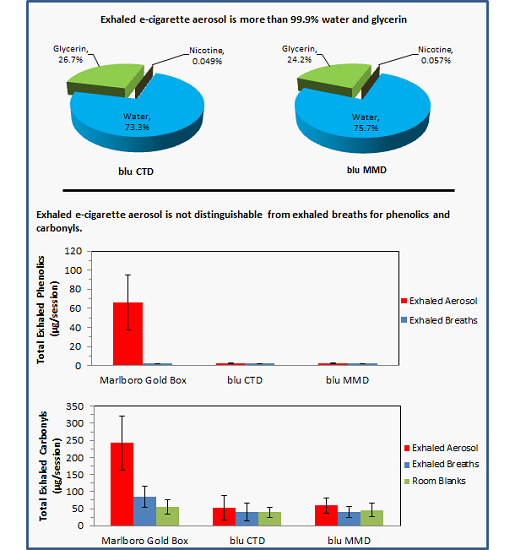Comparison of Select Analytes in Exhaled Aerosol from E-Cigarettes with Exhaled Smoke from a Conventional Cigarette and Exhaled Breaths
Abstract
:1. Introduction
2. Experimental Section
2.1. Materials
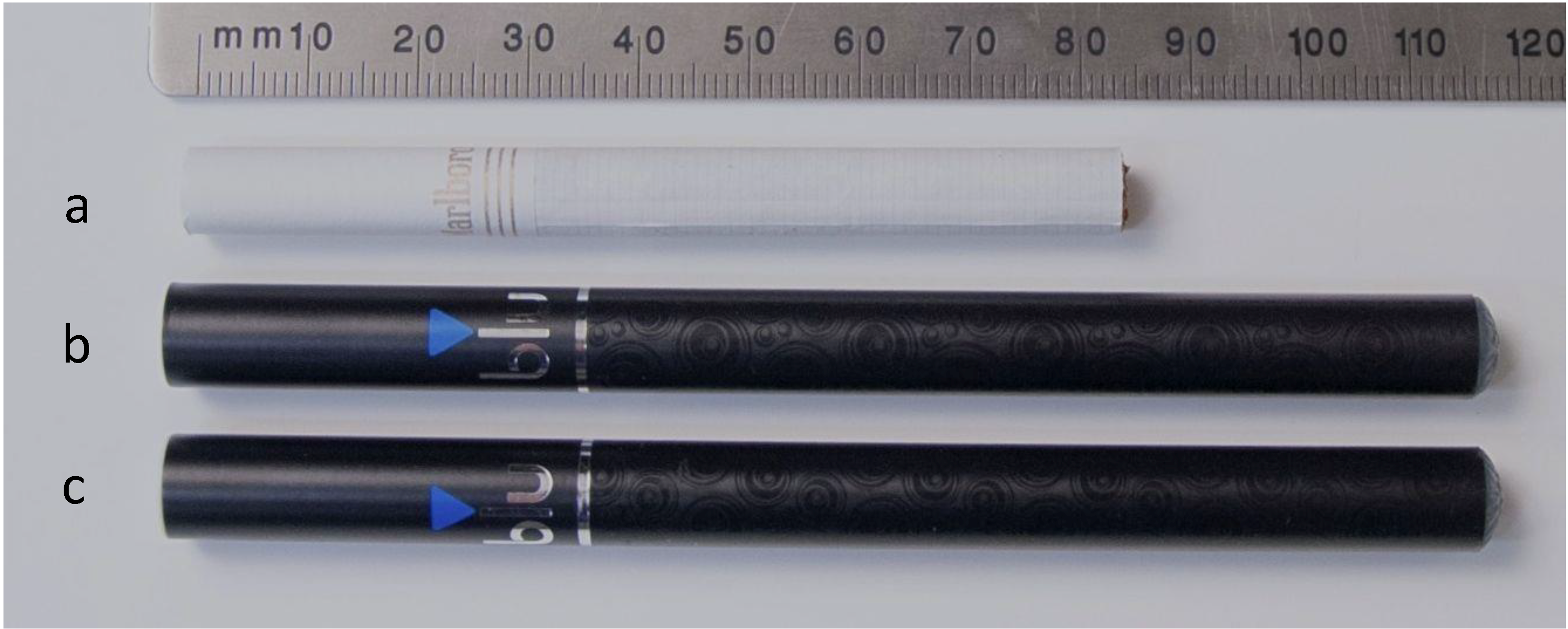
2.2. Experimental Design
| Analyte Class | Analyte |
|---|---|
| Major Components | Water |
| Glycerin | |
| Nicotine | |
| Phenolics | Hydroquinone |
| Resorcinol | |
| Catechol | |
| Phenol | |
| m,p-Cresol | |
| o-Cresol | |
| Carbonyls | Formaldehyde |
| Acetaldehyde | |
| Acetone | |
| Acrolein | |
| Propionaldehyde | |
| Crotonaldehyde | |
| Methylethylketone | |
| Butyraldehyde |
2.3. Exhaled Collection Method Summary
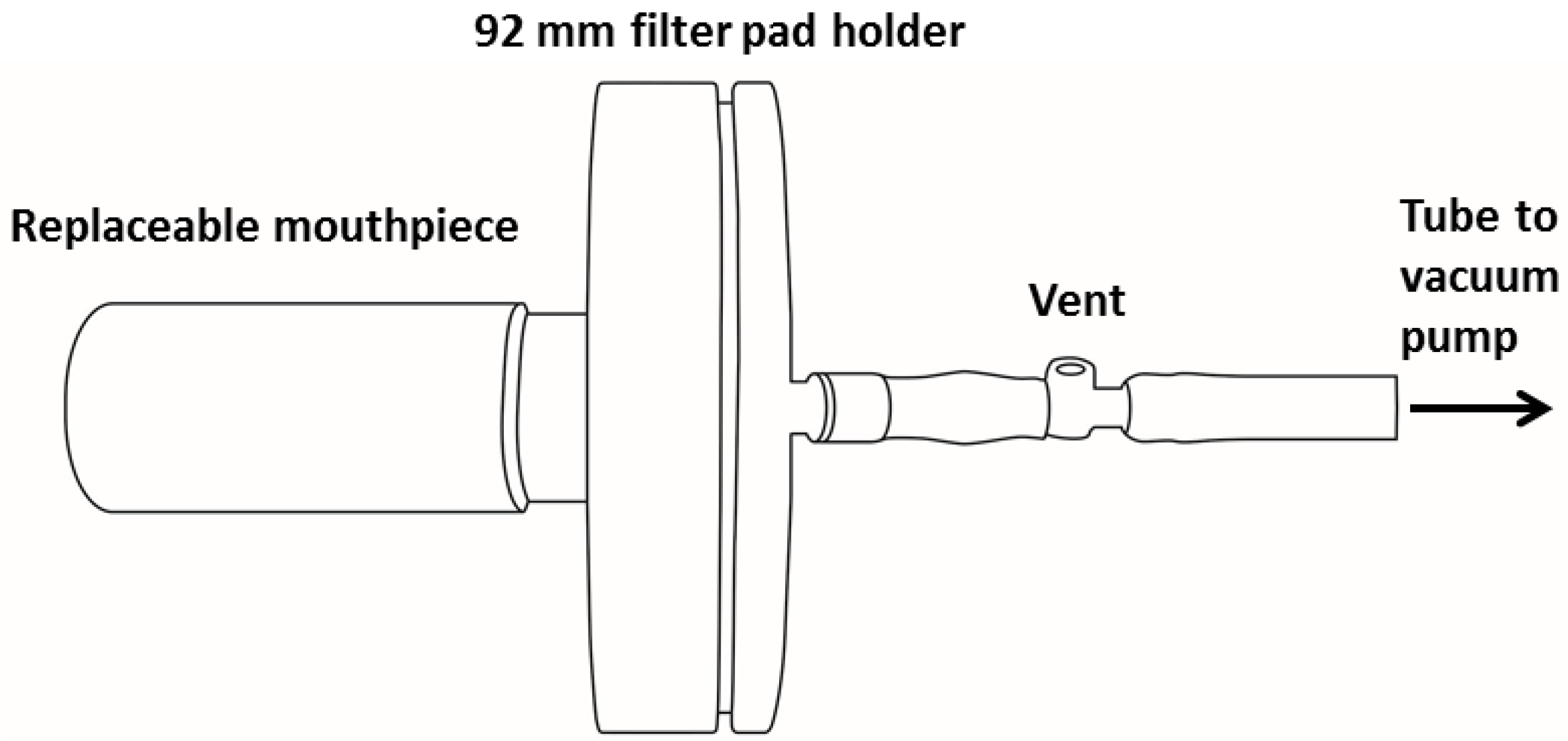
2.3.1. Exhaled Breath Blank Collections
2.3.2. Carbonyl Room Air Blank Collections
2.3.3. Analytical Method Capabilities Summary
| Analyte | LOD | LOQ | Accuracy (%) | Precision (%) | |
|---|---|---|---|---|---|
| Major Components | Nicotine | 0.69 | 4.86 | 108 | 2 |
| Glycerin | 0.0059 | 1.51 | 101 | 2 | |
| Water | ND | 31 | 99 | 0 | |
| Phenolics | Hydroquinone | 0.37 | 2.00 | 113 | 2 |
| Resorcinol | 0.06 | 0.40 | 109 | 2 | |
| Catechol | 0.47 | 2.00 | 114 | 2 | |
| Phenol | 0.09 | 0.32 | 108 | 2 | |
| m,p-Cresol | 0.60 | 4.00 | 110 | 2 | |
| o-Cresol | 0.16 | 1.00 | 113 | 1 | |
| Carbonyls | Formaldehyde | 0.10 | 12.45 | 97 | 0 |
| Acetaldehyde | 0.39 | 5.20 | 96 | 1 | |
| Acetone | 0.61 | 13.64 | 96 | 3 | |
| Acrolein | 0.13 | 12.34 | 97 | 0 | |
| Propionaldehyde | 0.21 | 1.89 | 98 | 2 | |
| Crotonaldehyde | 0.21 | 2.17 | 95 | 1 | |
| Methylethylketone | 0.24 | 2.06 | 97 | 2 | |
| Butyraldehyde | 0.18 | 5.30 | 95 | 1 | |
3. Results and Discussion
3.1. Exhaled Aerosol Mass Balance Distribution of Water, Glycerin and Nicotine

3.2. Exhaled Phenolics and Carbonyls
| MGB | Blu CTD | Blu MMD | ||||||
|---|---|---|---|---|---|---|---|---|
| Subject | Acetaldehyde | Hydroquinone | Subject | Acetaldehyde | Hydroquinone | Subject | Acetaldehyde | Hydroquinone |
| 1 | 227.6 | 70.6 | 11 | <LOQ | <LOD | 21 | 16.7 | <LOD |
| 186.0 | 60.0 | <LOQ | <LOD | 35.3 | <LOD | |||
| 221.0 | 69.1 | <LOQ | <LOD | 38.9 | <LOD | |||
| 2 | 134.7 | 41.3 | 12 | <LOQ | <LOD | 22 | <LOQ | <LOD |
| 129.8 | 33.2 | <LOQ | <LOD | <LOQ | <LOD | |||
| 107.7 | 31.9 | <LOQ | <LOD | <LOQ | <LOD | |||
| 3 | 131.2 | 32.2 | 13 | <LOQ | <LOD | 23 | <LOQ | <LOD |
| 169.0 | 47.4 | 86.4 | <LOD | <LOQ | <LOD | |||
| 128.1 | 52.5 | 44.2 | <LOD | <LOQ | <LOD | |||
| 4 | 115.6 | 48.5 | 14 | <LOQ | <LOD | 24 | 5.4 | <LOD |
| 119.3 | 47.3 | <LOQ | <LOD | 7.2 | <LOD | |||
| 124.1 | 42.5 | <LOQ | <LOD | 9.9 | <LOD | |||
| 5 | 195.4 | 18.4 | 15 | <LOQ | <LOD | 25 | <LOQ | <LOD |
| 122.0 | 13.3 | <LOQ | <LOD | <LOQ | <LOD | |||
| 196.3 | 20.0 | <LOQ | <LOD | <LOQ | <LOD | |||
| 6 | 208.0 | 99.5 | 16 | <LOQ | <LOD | 26 | <LOQ | <LOD |
| 116.9 | 103.5 | <LOQ | <LOD | <LOQ | <LOD | |||
| 116.0 | 83.9 | <LOQ | <LOD | <LOQ | <LOD | |||
| 7 | <LOQ | 22.8 | 17 | <LOQ | <LOD | 27 | <LOQ | <LOD |
| 88.1 | 8.79 | <LOQ | <LOD | <LOQ | <LOD | |||
| 48.1 | 25.9 | <LOQ | <LOD | 6.2 | <LOD | |||
| 8 | 380.2 | 29.1 | 18 | <LOD | <LOD | 28 | <LOQ | <LOD |
| 193.7 | 37.7 | 24.2 | <LOD | <LOQ | <LOD | |||
| 189.7 | 30.9 | <LOQ | <LOD | 7.1 | <LOD | |||
| 9 | 285.2 | 73.0 | 19 | <LOQ | <LOD | 29 | 6.5 | <LOD |
| 126.6 | 26.8 | <LOQ | <LOD | 8.9 | <LOD | |||
| 104.6 | 81.6 | <LOQ | <LOD | 7.6 | <LOD | |||
| 10 | 217.6 | 43.0 | 20 | 6.9 | <LOD | 30 | <LOQ | <LOD |
| 162.7 | 46.2 | <LOQ | <LOD | <LOQ | <LOD | |||
| 114.1 | 64.0 | <LOQ | <LOQ | 5.4 | <LOD | |||
| Avg * | 156.7 | 46.8 | <9.73 * | <0.421 * | <8.29 * | <0.367 * | ||
| SD | 68.8 | 24.7 | 16.5 | 0.3 | 8.2 | 0.0 | ||
| LOQ | 41.6 | 2.00 | 5.20 | 2.00 | 5.20 | 2.00 | ||
| LOD | 0.390 | 0.367 | 0.390 | 0.367 | 0.390 | 0.367 | ||
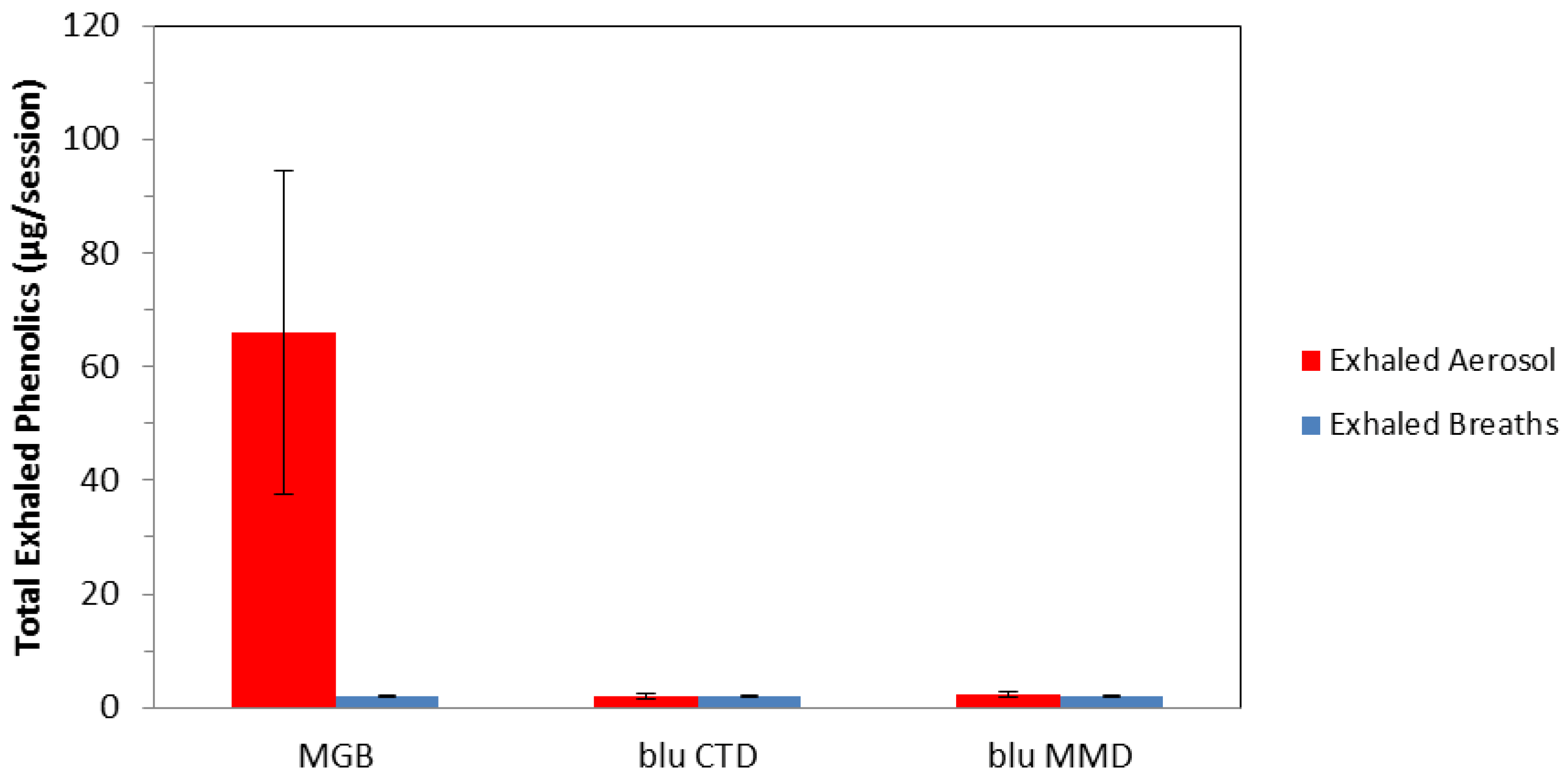
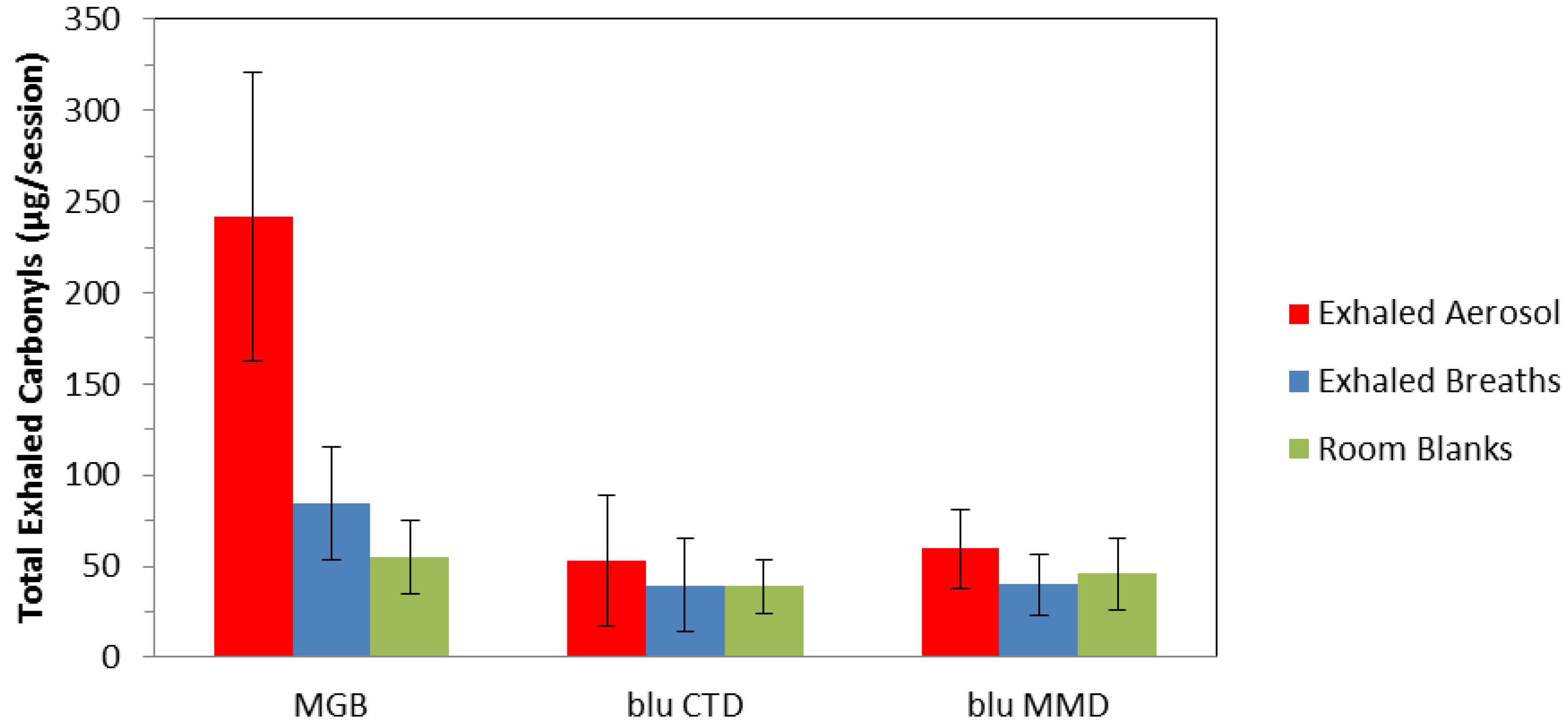
| Analyte | Blu CTD | Blu MMD | |||||
|---|---|---|---|---|---|---|---|
| Aerosol | Breaths | Air | Aerosol | Breaths | Air | ||
| Hydroquinone | Mean | <0.421 * | <0.367 * | ND | <0.367 * | <0.367 * | ND |
| SD | 0.3 | 0.0 | ND | 0.0 | 0.0 | ND | |
| Acetaldehyde | Mean | <9.73 * | <9.58 * | <3.60 * | <8.29 * | <5.20 * | <5.20 * |
| SD | 16.5 | 16.0 | 2.3 | 8.2 | 0.0 | 0.0 | |
4. Conclusions
Supplementary Files
Supplementary File 1Acknowledgments
Conflicts of Interest
References
- Regan, A.K.; Promoff, G.; Dube, S.R.; Arrazola, R. Electronic nicotine delivery systems: Adult use and awareness of the “e-cigarette” in the USA. Tob. Control 2013, 22, 19–23. [Google Scholar] [CrossRef] [PubMed]
- Laugesen, M. Safety Report on the Ruyan® E-cigarette Cartridge and Inhaled Aerosol; Public Health Medicine Registrar, Auckland District Health Board: Auckland, New Zealand, 2008. [Google Scholar]
- Laugesen, M. Poster 5–11; Society for Research on Nicotine and Tobacco (SRNT): Dublin, Ireland, 2009. [Google Scholar]
- Cahn, Z.; Siegel, M. Electronic cigarettes as a harm reduction strategy for tobacco control: A step forward or a repeat of past mistakes? J. Public Health Policy 2010. [Google Scholar] [CrossRef]
- Pellegrino, R.M.; Tinghino, B.; Mangiaracina, G.; Marani, A.; Vitali, M.; Protano, C.; Osborn, J.F.; Cattaruzza, M.S. Electronic cigarettes: An evaluation of exposure to chemicals and fine particulate matter (PM). Ann. Ig. 2012, 24, 279–288. [Google Scholar] [PubMed]
- Goniewicz, M.L.; Knysak, J.; Gawron, M.; Kosmider, L.; Sobczak, A.; Kurek, J.; Prokopowicz, A.; Jablonska-Czapla, M.; Rosik-Dulewska, C.; Havel, C. Levels of selected carcinogens and toxicants in vapour from electronic cigarettes. Tob. Control 2013. [Google Scholar] [CrossRef]
- Goniewicz, M.L.; Kuma, T.; Gawron, M.; Knysak, J.; Kosmider, L. Nicotine levels in electronic cigarettes. Nicotine Tob. Res. 2012, 1, 158–166. [Google Scholar]
- Goniewicz, M.L.; Hajek, P.; McRobbie, H. Nicotine content of electronic cigarettes, its release in vapour and its consistency across batches: Regulatory implications. Addiction 2014, 109, 341–515. [Google Scholar] [PubMed]
- U.S. Federal Register; No. 64; U.S. Government Federal Register: Washington, D.C., USA, 2012; Volume 77; pp. 20034–20037.
- Lauterbach, J.H.; Laugesen, M. Comparison of Toxicant Levels in Mainstream Aerosols Generated by Ruyan Electronic Nicotine Delivery Systems (ENDS) and Conventional Cigarette Products; Society of Toxicology Poster: San Francisco, CA, USA, 2012. [Google Scholar]
- Uchiyama, S.; Inaba, Y.; Kunugita, N. Determination of acrolein and other carbonyls in cigarette smoke using coupled silica cartridges impregnated with hydroquinone and 2,4-dinitrophenylhydrazine. J. Chromatogr. A 2010, 1217, 4383–4388. [Google Scholar] [PubMed]
- McAuley, T.R.; Hopke, P.K.; Zhao, J.; Babaian, S. Comparison of the effects of e-cigarette vapor and cigarette smoke on indoor air quality. Inhal. Toxicol. 2012, 24, 850–857. [Google Scholar] [CrossRef] [PubMed]
- Riker, C.A.; Lee, K.; Darville, A.; Hahn, E. E-cigarettes: Promise or peril? J. Nurs. Clin. North Am. 2012, 47, 159–171. [Google Scholar] [CrossRef] [PubMed]
- Guerin, M.R.; Jenkins, R.A.; Tomkins, B.A. The Chemistry of Environmental Tobacco Smoke: Composition and Measurement; Lewis: Chelsea, MI, USA, 1992; pp. 41–55. [Google Scholar]
- Czogala, J.; Goniewicz, M.L.; Fidelus, B.; Zielinska-Danch, W.; Sobczak, A. Assessment of Passive Exposure to Aerosol from Electronic Cigarettes. In Proceedings of the Society for Research on Nicotine and Tobacco (SRNT) Conference, Boston, MA, USA, 13–16 March 2013.
- Romagna, G.; Zabarini, L.; Barbiero, L.; Bocchietto, E.; Todeschi, S.; Caravati, E.; Voster, D.; Farsalinos, K. Characterization of Chemicals Released to the Environment by Electronic Cigarettes Use (ClearStream-AIR Project): Is Passive Vaping a Reality? In Proceedings of the XIV Annual Meeting of the Society for Research on Nicotine and Tobacco, Helsinki, Finland, 30 August 2012.
- Schripp, T.; Markewitz, D.; Uhde, E.; Salthammer, T. Does e-cigarette consumption cause passive vaping? Indoor Air 2013, 23, 25–31. [Google Scholar] [CrossRef]
- Schober, W.; Szendrei, K.; Matzen, W.; Osiander-Fuchs, H.; Heitmann, D.; Schettgen, T.; Jörres, R.A.; Fromme, H. Use of electronic cigarettes (e-cigarettes) impairs indoor air quality and increases FeNO levels of e-cigarette consumers. Int. J. Hyg. Environ. Health 2013, 217, 628–637. [Google Scholar] [CrossRef] [PubMed]
- Sarigiannis, D.A.; Karakitsios, S.P.; Gotti, A.; Liakos, L.L.; Katsoyiannis, A. Exposure to major volatile organic compounds and carbonyls in European indoor environments and associated health risk. Environ. Int. 2011, 37, 743–765. [Google Scholar] [CrossRef] [PubMed]
- Geiss, O.; Giannopoulos, G.; Tirendi, S.; Barrero-Moreno, J.; Larsen, B.R.; Kotzias, D. The AIRMEX study—VOC measurements in public buildings and schools/kindergartens in eleven European cities: Statistical analysis of the data. Atmos. Environ. 2011, 45, 3676–3684. [Google Scholar] [CrossRef]
- Reiss, R.; Ryan, P.B.; Tibbetts, S.J.; Koutrakis, P. Measurement of organic acids, aldehydes, and ketones in residential environments and their relation to ozone. J. Air Waste Manage. Assoc. 1995. [Google Scholar] [CrossRef]
- Liu, K.S.; Huang, F.Y.; Hayward, S.B.; Wesolowski, J.; Sextont, K. Irritant effects of formaldehyde Exposure in mobile homes. Environ. Health Perspect. 1991, 94, 91–94. [Google Scholar] [PubMed]
- Moldoveanu, S.; Coleman, W.; Wilkin, J.; Reynolds, R.J. Determination of hydroxybenzenes in exhaled cigarette smoke. Beitr. Tabakforschung Int. 2008, 23, 98–106. [Google Scholar]
- Moldoveanu, S.; Coleman, W.; Wilkin, J. Determination of carbonyls in exhaled cigarette smoke. Beitr. Tabakforschung Int. 2007, 22, 346–357. [Google Scholar]
- Moldoveanu, S.; Coleman, W.; Wilkin, J. Determination of benzene and toluene in exhaled cigarette smoke. Beitr. Tabakforschung Int. 2008, 23, 106–114. [Google Scholar]
- Moldoveanu, S.; Coleman, W.; Wilkin, J. Determination of polycyclic aromatic hydrocarbons in exhaled cigarette smoke. Beitr. Tabakforschung Int. 2008, 23, 85–97. [Google Scholar]
- Fenk, S.; Plunkett, S.E.; Lam, K.; Kapur, S.; Muhammad, R.; Jin, Y.; Zimmerman, M.; Mendes, P.; Kinserand, R.; Roethig, H. A new method for estimating the retention of selected smoke constituents in the respiratory tract of smokers during cigarette smoking, inhalation. Toxicology 2006, 19, 169–179. [Google Scholar]
- Maxwell, J.C. The Maxwell Report: Year End & Fourth Quarter 2011 Sales Estimates for the Cigarette Industry; Maxwell, J.C., Jr., Ed.; UCSF Library: Richmond, VA, USA, 2012. [Google Scholar]
- Tayyarah, R.; Long, G.A. Comparison of select analytes in aerosol from e-cigarettes with smoke from a conventional cigarette and with ambient air. Regul. Toxicol. Pharmacol. 2014, in press. [Google Scholar] [CrossRef]
- Cheng, T. Chemical evaluation of electronic cigarettes. Tob. Control 2014, 23. [Google Scholar] [CrossRef]
- Cabot, R.; Koc, A.; Yurteri, C.U.; McAughey, J. Aerosol Characterization of E-Cigarettes. In Proceedings of the European Aerosol Conference, Prague, Czech, 1–6 September 2013.
- Eclipse—A Cigarette that Primarily Heats, rather than Burns Tobacco, Summary of Scientific Tests; RJ Reynolds Tobacco Company: Winston-Salem, NC, USA, 2000.
- Chemical and Biological Studies on New Cigarette Prototypes that Heat Instead of Burn Tobacco; RJ Reynolds Tobacco Company: Winston-Salem, NC, USA, 1988; pp. 134–135.
- Robinson, E.A.; Brown, S.E.; Leverette, R.D.; Misra, M. Evaluation of the potential for second-hand exposure to e-cigarette aerosol in an office environment: Comparison with tobacco cigarette and scented candle. Int. J. Environ. Res. Public Health 2014, in press. [Google Scholar]
© 2014 by the authors; licensee MDPI, Basel, Switzerland. This article is an open access article distributed under the terms and conditions of the Creative Commons Attribution license (http://creativecommons.org/licenses/by/4.0/).
Share and Cite
Long, G.A. Comparison of Select Analytes in Exhaled Aerosol from E-Cigarettes with Exhaled Smoke from a Conventional Cigarette and Exhaled Breaths. Int. J. Environ. Res. Public Health 2014, 11, 11177-11191. https://doi.org/10.3390/ijerph111111177
Long GA. Comparison of Select Analytes in Exhaled Aerosol from E-Cigarettes with Exhaled Smoke from a Conventional Cigarette and Exhaled Breaths. International Journal of Environmental Research and Public Health. 2014; 11(11):11177-11191. https://doi.org/10.3390/ijerph111111177
Chicago/Turabian StyleLong, Gerald A. 2014. "Comparison of Select Analytes in Exhaled Aerosol from E-Cigarettes with Exhaled Smoke from a Conventional Cigarette and Exhaled Breaths" International Journal of Environmental Research and Public Health 11, no. 11: 11177-11191. https://doi.org/10.3390/ijerph111111177
APA StyleLong, G. A. (2014). Comparison of Select Analytes in Exhaled Aerosol from E-Cigarettes with Exhaled Smoke from a Conventional Cigarette and Exhaled Breaths. International Journal of Environmental Research and Public Health, 11(11), 11177-11191. https://doi.org/10.3390/ijerph111111177



